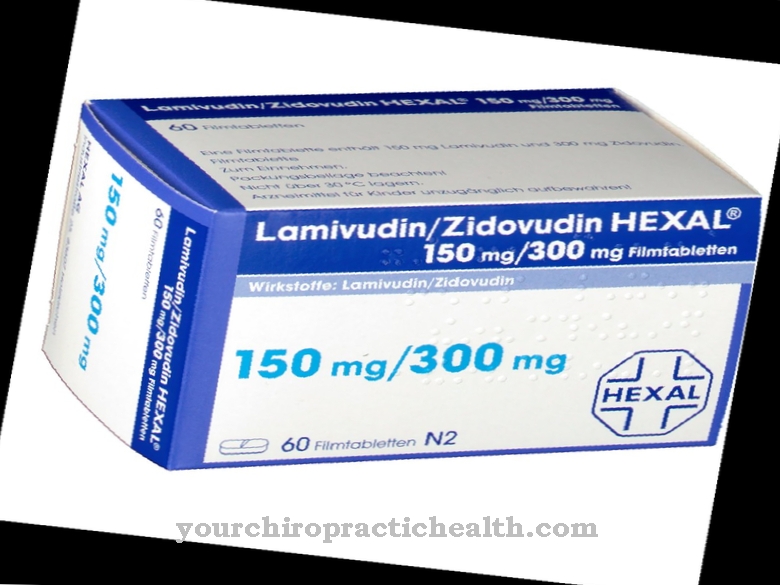The drug Sertraline belongs to the selective serotonin reuptake inhibitors (SSRI). These are mainly used to treat depression.
What is sertraline?

The antidepressant sertraline, like the antidepressants citalopram and fluoxetine, is one of the selective serotonin reuptake inhibitors. These influence the neurotransmitter balance and have a mood-enhancing effect. This is why the active ingredient sertraline is used, among other things, to treat anxiety disorders, obsessive-compulsive disorders and post-traumatic stress disorder (PTSD).
Like the other selective serotonin reuptake inhibitors, sertraline can cause various side effects. Serotonin syndrome, which can occur with simultaneous use of various serotonergic drugs or with an overdose of sertraline, is particularly feared.
Pharmacological effect
Sertraline works in the synaptic cleft in the central nervous system. The synaptic gap lies between a nerve cell and a downstream other (nerve) cell. Excitation is transmitted through the synaptic gap. For this, messenger substances, the so-called neurotransmitters, are required.
Serotonin is one of those neurotransmitters. The messenger substance acts in the central nervous system and is known for its mood-enhancing effect. That is why serotonin is popularly known as the happiness hormone.
Many depression and anxiety disorders are believed to be due to a lack of serotonin. Selective serotonin reuptake inhibitors are designed to increase the concentration of serotonin in the synaptic cleft. Sertraline prevents the absorption of serotonin from the synaptic gap in the surrounding cells. This means that more serotonin remains in the gap, so that the serotonergic effect is increased. The drug unfolds its drive-enhancing effect during the first intake. This effect intensifies and manifests itself over the next one to three weeks.
Medical application & use
Sertraline is useful for treating major depression. In short-term use, the active ingredient was clearly superior to placebo. This does not apply to all selective serotonin reuptake inhibitors.
Sertraline has also been shown to be helpful in the treatment of obsessive-compulsive disorders and panic disorders. In patients with a social phobia, the active ingredient can also be used for therapy, but it takes around six weeks to 3 months for the first treatment success to be visible.
The active ingredient is also widely used in the treatment of post-traumatic stress disorder. Here too, however, delayed treatment success must be taken into account. Often an improvement only becomes apparent after about three months. The following applies: the more severe the symptoms, the longer it takes for the patient to react to the drug.
You can find your medication here
➔ Medicines against depressive moods & to lighten the moodRisks & side effects
Side effects are quite common when taking sertraline. More than 10 percent of patients treated with sertraline experience insomnia, fatigue, dizziness and headaches. Gastrointestinal disorders and dry mouth are also seen more frequently.
As with most selective serotonin reuptake inhibitors, sertraline can cause sexual dysfunction. Ejaculation failure and inability to orgasm are often observed in men. Usually these sexual dysfunctions are reversible. However, there are also patients in whom symptoms persist for several weeks or even months after stopping the drug.
Common side effects also include vomiting, profuse sweating, rash, and blurred vision. Hot flashes, discomfort when urinating, heart palpitations, and chest pain are also observed. Hallucinations, liver failure, coma, psychoses and the Stevens-Johnson syndrome occur more often in connection with the intake of sertraline, but a causal connection has not yet been proven.
Special care should be taken in manic or hypomanic patients. Some test patients got worse manic symptoms while taking Seratralin. Occasionally, however, there is also excessive euphoria, depression or hallucinations.
Studies have also shown that suicidal behavior is encouraged in children and adolescents. Children and adolescents are significantly more likely to have suicidal thoughts than children and adolescents who are treated with other drugs. Increased hostility with increased aggression can also be observed. These side effects also occur rarely in adults.
A rather rare but dangerous side effect is serotonin syndrome. This occurs especially when sertraline is combined with other centrally acting drugs. These include medicines for depression (e.g. lithium or St. John's wort), triptan-type medicines for migraine, and tryptophan. Serotonin syndrome manifests itself through muscle tremors, high fever, clouding of consciousness and muscle rigidity.
Since MAO inhibitors increase the serotonergic effect of sertraline, they must not be administered together with the selective serotonin reuptake inhibitor. Alcohol should also be avoided while taking it. The combination of sertraline with phenytoin and platelet aggregation inhibitors is also not recommended. Sertraline can also influence the effect of coumarins (vitamin K antagonists).
Sertraline should not be stopped suddenly. If the active ingredient is discontinued too quickly and not tapered off, the patient can experience fear, dizziness, excitement, headache, tremors, nausea and sweating. Although the symptoms subside within 14 days, it can, under certain circumstances, take several months for all adverse drug effects to disappear.
Women who are of childbearing potential should only take the active ingredient sertraline with adequate contraception. The drug enters the child's organism via the placenta and the umbilical cord. So far, no harmful effects of the drug on the unborn child have been found, but damage cannot be ruled out. Breastfeeding mothers should also avoid sertraline during breastfeeding.



























